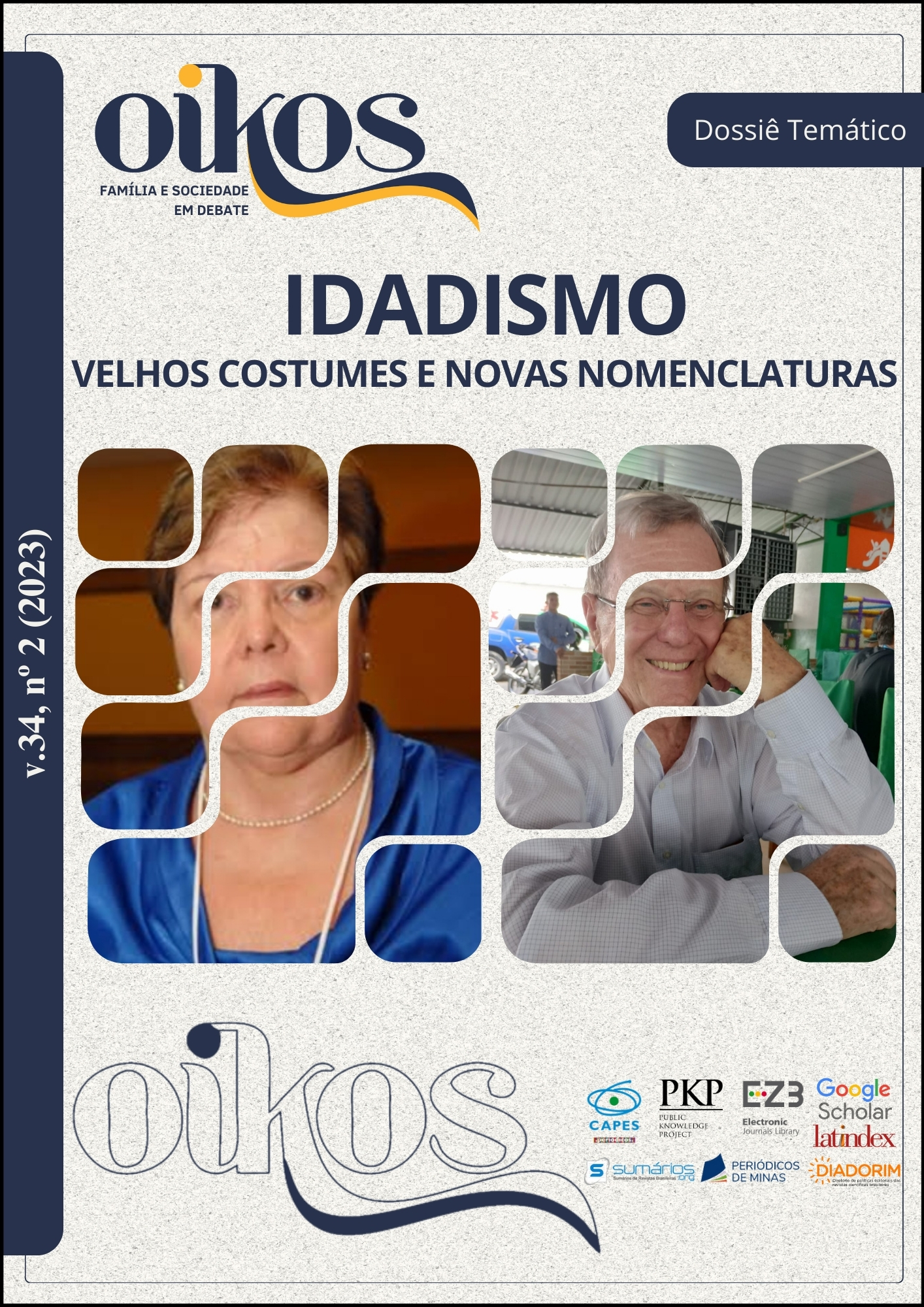AGEISM IN THE WORLD OF WORK
DOI:
https://doi.org/10.31423/oikos.v34i2.15267Keywords:
Emprego, Pessoa idosa, Reinserção no mercado de trabalhoAbstract
This qualitative study aimed to analyze ageism in relation to elderly people in the labor market, as well as their social and salary representations, in relation to younger people. The study was developed through a literature review, in the Google Scholar database, including only scientific articles published in the last 5 years. A total of 689 studies were found, and after the review steps, 10 studies were considered eligible for such a review. The results show that ageism is present in all recruitment phases carried out by companies, represented by low wages and few vacancies offered to this population demand. It is concluded that more robust public policies are needed to support this population lacking opportunities in the field of work, for improvements in quality of life as a result of reintegration into the labor market and social environment.
Downloads
References
ALMEIDA, Carlos Pedro et al. A força de trabalho ‘grisalha’: mitos e estereótipos sobre a contratação de pessoas mais velhas. New Trends in Qualitative Research, v. 14, p. e586-e586, 2022.
AMORIM, Wilson; FISCHER, AndréLuiz; FEVORINI, Fabiana Bitencourt. Workers age 50 and over in the Brazilian labor market: is there ageism?. Revista de Gestão, v. 26, n. 2, p. 161-179, 2019.
AXELRAD, Hila; JAMES, Jacquelyn B. Employers’ attitudes toward older-worker job seekers: a comprehensive review with recommendations for action. The Aging Workforce Handbook, 2016.
BARROS, Luana de; RAYMUNDO, Taiuani Marquine. Envelhecimento, trabalho e tecnologia: motorista de aplicativos como possibilidade laboral para a população 50+. Cadernos Brasileiros de Terapia Ocupacional, v. 29, 2021.
BLOOM, David E. et al. Macroeconomic implications of population ageing and selected policy responses. The Lancet, v. 385, n. 9968, p. 649-657, 2015.
CHUDACOFF, Howard P. How old are you?. In: How Old Are You?. Princeton University Press, 2021.
GORDON, Robert D. Values of Mills' ratio of area to bounding ordinate and of the normal probability integral for large values of the argument. The Annals of Mathematical Statistics, v. 12, n. 3, p. 364-366, 1941.
GLOVER, Ian; BRANINE, Mohamed (Ed.). Ageism in work and employment. Routledge, 2017.
HANASHIRO, Darcy Mitiko Mori; PEREIRA, Marie Françoise Marguerite Winandy Martins. O etarismo no local de trabalho: evidências de práticas de “saneamento” de trabalhadores mais velhos. Revista Gestão Organizacional, v. 13, n. 2, p. 188-206, 2020.
HEIM, Bradley T. The incredible shrinking elasticities married female labor supply, 1978–2002. Journal of Human resources, v. 42, n. 4, p. 881-918, 2007.
HECKMAN, James J. Sample selection bias as a specification error. Econometrica: Journal of the econometric society, p. 153-161, 1979.
LAGACÉ, Martine et al. Testing the Shielding Effect of Intergenerational Contact against Ageism in the Workplace: A Canadian Study. International Journal of Environmental Research and Public Health, v. 19, n. 8, p. 4866, 2022.
LOVERIDGE, Ray; MOK, Albert Louis. Theories of labour market segmentation: a critique. Springer Science & Business Media, 2012.
NEUMARK, David. Age discrimination in the US labor market. Generations, v. 43, n. 3, p. 51-58, 2019.
OCHÔA, Paula; BARATA, Paulo JS. ENVELHECIMENTO E IDADISMO NA PROFISSÃO DE INFORMAÇÃO-DOCUMENTAÇÃO: debater o que não sabemos no presente, perspetivar o futuro. Páginas a&b: arquivos e bibliotecas, p. 140-156, 2018.
DE OLIVEIRA, Elizângela Farias. 50+ e o mercado de trabalho: Um estudo de campo na região centro-oeste do Brasil. Revista Longeviver, 2021.
PALMORE, Erdman B.; BRANCH, Laurence; HARRIS, Diane. Encyclopedia of ageism. Routledge, 2016.
POSTHUMA, Richard A.; WAGSTAFF, Maria Fernanda; CAMPION, Michael A. 16 age stereotypes and workplace age discrimination. The Oxford handbook of work and aging, p. 298, 2012.
DOS SANTOS, Gabriele Thaís et al. A INTERGERACIONALIDADE NO MERCADO DE TRABALHO: DESAFIOS E POTENCIALIDADES. Revista Ibero-Americana de Humanidades, Ciências e Educação, v. 8, n. 12, p. 505-528, 2022.
SWIFT, Hannah J. et al. The risks of ageism model: How ageism and negative attitudes toward age can be a barrier to active aging. Social Issues and Policy Review, v. 11, n. 1, p. 195-231, 2017.
WORLD HEALTH ORGANIZATION et al. Global report on ageism. World Health Organization, 2021.
Downloads
Published
How to Cite
Issue
Section
License
Copyright (c) 2023 Oikos: Família e Sociedade em Debate

This work is licensed under a Creative Commons Attribution 4.0 International License.
A revista se reserva o direito de efetuar, nos originais, alterações de ordem normativa, ortográfica e gramatical, com vistas a manter o padrão culto da língua, respeitando, porém, o estilo dos autores.
Os trabalhos publicados passam a ser propriedade da revista Oikos: Família e Sociedade em Debate. Deve ser consignada a fonte de publicação original. Para a disponibilização e utilização dos artigos em acesso aberto, o periódico adota a licença Creative Commons Attribution 4.0 International Public License: CC BY 4.0. Isso significa que outras pessoas podem compartilhar - copiar ou distribuir o material em qualquer mídia ou formato; adaptar - remixar, transformar e criar a partir do material para qualquer fim, desde que atribuído o devido crédito, fornecer um link para a licença e indicar se foram feitas alterações" (CC BY 4.0).
As opiniões emitidas pelos autores dos artigos são de sua exclusiva responsabilidade.
Quanto às questões de plágio, a Oikos utiliza o software de verificação de similaridade de conteúdo – política de plágio (CopySpider) nos artigos submetidos ao periódico.
Ao submeter o artigo, o autor se compromete que os dados relatados no artigo não são resultados de má conduta ética, tais como: dados produzidos, uso indevido de imagens, falsificação, plágio, autoplágio ou duplicidade. O autor declara que nada no artigo infringe qualquer direito autoral ou de propriedade intelectual de outrem, pois, caso contrário, ele poderá responder integralmente por qualquer dano causado a terceiros, em todas as esferas administrativas e jurídicas cabíveis, nos estritos termos da Lei nº 9.610/98



